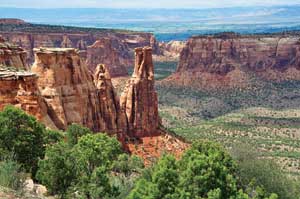Management Practices for Different Forest Types
Colorado’s forest types evolved throughout our six ecoregions with varying sunlight, nutrient, water and elevational adaptations.
Requirements for Colorado’s major tree species are varied, as are the management approaches that are appropriate for these forest types.
For instance, management practices that encourage healthy forest conditions in ponderosa pine in the montane zone will not be appropriate for lodgepole pine, spruce-fir, piñon-juniper or aspen forests. The needs of these forest types are vastly different, and therefore, effective management strategies to encourage healthy forests in these various types also will vary.
Your Local Forester can give you assistance in this area.
Lodgepole Pine Management
Lodgepole pine, (Pinus contorta) is a familiar species in the montane and subalpine forests of Colorado’s Rocky Mountains. It grows at elevations between 6,000 and 11,000 feet. As a consequence of the current mountain pine beetle epidemic, many landowners and land managers are concerned about how to actively manage lodgepole pine stands to:
- Treat the dead standing trees killed by the insects
- Protect homes and communities from wildfire
- Ensure that the future forest is better structured to prevent widespread mortality from insect epidemics and wildfire
Learn more in Lodgepole Pine Management Guidelines for Land Managers in the Wildland-Urban Interface (1.3 MB PDF)
Gambel Oak Management
Gambel Oak (Quercus gambelii) is a shrub mostly found along the Front Range to southern Colorado. It grows at elevations between 6,000 and 9,000 feet. Management of gambel oak is important because after recurring fires the shrubs can grow into thick clumps. This may decrease the benefits for wildlife or livestock and increase wildfire risk.
Learn about gambel oak management (1.3 MB PDF)
Piñon-Juniper Management

Piñon-juniper woodlands are widespread in Colorado’s lower elevations, ranging from 4,900 to 8,000 feet on Colorado’s Western Slope and in limited distribution in south-central Colorado and the Eastern Plains.
<a In southeastern Colorado, piñon-juniper ecosystems are found in the canyonlands and adjacent shortgrass prairie ecosystems below the Gambel oak zone.
Learn about piñon-juniper management (401 KB PDF)

